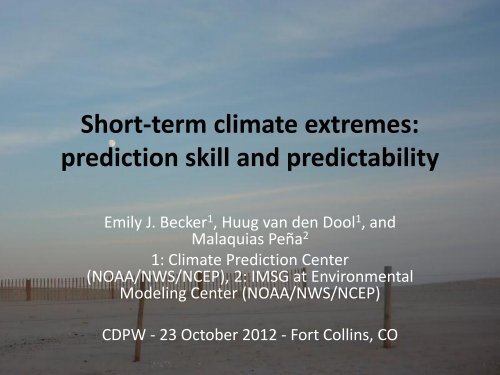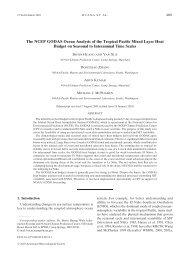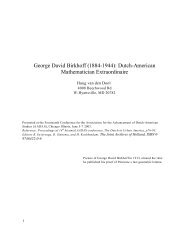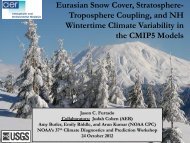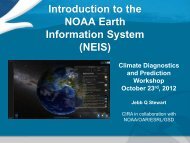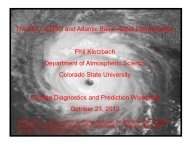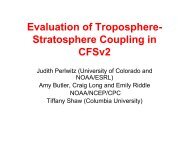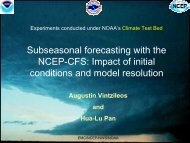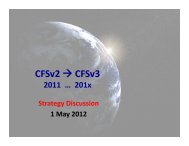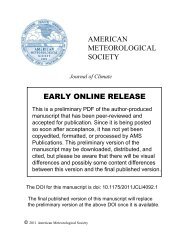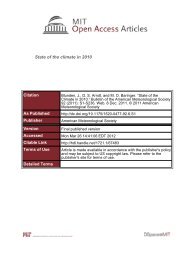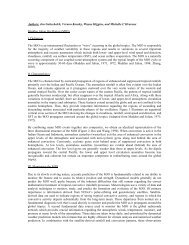Short-term climate extremes: prediction skill and predictability
Short-term climate extremes: prediction skill and predictability
Short-term climate extremes: prediction skill and predictability
Create successful ePaper yourself
Turn your PDF publications into a flip-book with our unique Google optimized e-Paper software.
<strong>Short</strong>-<strong>term</strong> <strong>climate</strong> <strong>extremes</strong>:<br />
<strong>prediction</strong> <strong>skill</strong> <strong>and</strong> <strong>predictability</strong><br />
Emily J. Becker 1 , Huug van den Dool 1 , <strong>and</strong><br />
Malaquias Peña 2<br />
1: Climate Prediction Center<br />
(NOAA/NWS/NCEP), 2: IMSG at Environmental<br />
Modeling Center (NOAA/NWS/NCEP)<br />
CDPW - 23 October 2012 - Fort Collins, CO
How well can we currently predict<br />
short-<strong>term</strong> <strong>climate</strong> <strong>extremes</strong><br />
• <strong>Short</strong>-<strong>term</strong> <strong>climate</strong> <strong>extremes</strong> (STCE): monthly<br />
or seasonal means well above or below the<br />
mean, at leads of 1 – 8 months.<br />
• Present-day <strong>prediction</strong> <strong>skill</strong> <strong>and</strong> <strong>predictability</strong><br />
• 2-meter surface temperature <strong>and</strong> precip. rate<br />
over North <strong>and</strong> South America; sea-surface<br />
temperature in Niño 3.4 region <strong>and</strong> Atlantic<br />
hurricane main development region (MDR)
Forecasts <strong>and</strong> Observations<br />
• Climate Forecast System version 2 ensemble<br />
mean reforecasts<br />
– 9-month leads, 1982-2010<br />
– all 12 initial months<br />
– regridded to resolution 1° x 1° (Saha et al. 2012)<br />
• Tmp2m: GHCN+CAMS, regridded to 1° x 1° (Fan<br />
<strong>and</strong> van den Dool 2008)<br />
• Precipitation rate: CPC global Unified Rain-Gauge<br />
Database, regridded to 1° x 1° (P. Xie et al. 2010).<br />
• Sea-surface temperature: OI-2 (Reynolds et al.<br />
2002), native resolution is 1° x 1°.
Methods<br />
• Systematic error correction to remove model<br />
bias: model climatology is removed, <strong>and</strong> replaced<br />
with climatology from observations<br />
• Cross-validation: “CV3RE”<br />
• Verification measures:<br />
– Anomaly correlation (AC)<br />
– Root-mean-square error (RMSE)<br />
• AC <strong>and</strong> RMSE are area-averaged over North<br />
America, South America (tmp2m <strong>and</strong> prate) <strong>and</strong><br />
Niño3.4 <strong>and</strong> MDR regions (SST).
The definition of extreme
The definition of extreme<br />
• Gridpoint monthly mean anomaly above/below<br />
+/- 1.645 st<strong>and</strong>ard deviations<br />
– Approximately equivalent to 5 th /95 th percentiles.<br />
– Other definitions were tested, with similar <strong>skill</strong><br />
findings.<br />
• Two scenarios:<br />
– Extreme is forecast: did it come true<br />
– Extreme was observed: was it forecast
Tmp2m:<br />
North Amer.<br />
• Sliding scale ranging<br />
from “all cases”<br />
included to 3.0xSD.<br />
• “Mod” = <strong>skill</strong> assessed<br />
for cases where an<br />
extreme was forecast<br />
• “Obs” = <strong>skill</strong> when an<br />
extreme was observed<br />
• Permutation tests of<br />
1,000 r<strong>and</strong>om subsets
Tmp2m:<br />
South Amer.<br />
T2m <strong>skill</strong> is higher in<br />
South America than<br />
North America
Tmp2m: North Amer.<br />
• Skill is often a<br />
function more of<br />
target than lead<br />
• STCE defined<br />
here by +/-<br />
1.645 std. dev.<br />
threshold
Tmp2m: South Amer.
Prate: NA<br />
• Precipitation is very<br />
difficult to forecast!<br />
• Cross-validation<br />
affects lower scores<br />
the most, <strong>and</strong><br />
leaves us with nearzero<br />
scores for<br />
precipitation rate
Precipitation rate: South Amer.
SST: Niño3.4 Region<br />
• Higher <strong>skill</strong> scores<br />
are not noticeably<br />
reduced by CV<br />
• RMSE is essentially<br />
flat with increase in<br />
threshold defining<br />
extreme
SST: Niño3.4 Region
SST: Atlantic hurricane dev. region<br />
SSTs in this region are<br />
important for<br />
hurricane forecasting
SST: Atlantic hurricane dev. region
Potential <strong>predictability</strong><br />
• Test how well the model predicts itself, under<br />
“perfect model” assumption.<br />
• Take one member from the ensemble of N<br />
members, verify “<strong>prediction</strong>” of ensemble<br />
mean of N-1 members against this member<br />
• Employ both CFSv1 <strong>and</strong> CFSv2, as (ideally) the<br />
<strong>predictability</strong> should not depend on the<br />
model.
Tmp2m <strong>predictability</strong>, North Amer.
Tmp2m <strong>predictability</strong>, South Amer.
Potential <strong>predictability</strong>: precip rate
Potential <strong>predictability</strong>: SST in Niño3.4
Potential <strong>predictability</strong>: SST in MDR
Summary (1/2)<br />
• Assessed model forecast <strong>skill</strong> of short-<strong>term</strong><br />
<strong>climate</strong> <strong>extremes</strong> (STCE) in 2 m temperature,<br />
precipitation rate, <strong>and</strong> sea surface<br />
temperature using CFSv2, 1982-2010.<br />
• Anomaly correlations for STCEs are routinely<br />
higher than for “all cases”.<br />
• RMSE, which can be considered as noise in a<br />
signal-to-noise ratio such as the AC, grows<br />
more slowly than the threshold: the signal<br />
grows despite increased noise.
Summary (2/2)<br />
• Cross-validation leads to lower ACs. ACs that are<br />
already low are affected the most: precipitation<br />
ACs are reduced to near zero, while SST ACs are<br />
largely unaffected.<br />
• Highest potential <strong>predictability</strong> for T2m in the<br />
first half of the year (both So. <strong>and</strong> No. Amer.)<br />
• Target months with higher <strong>predictability</strong> tend to<br />
have higher forecast <strong>skill</strong>, but forecast <strong>skill</strong> is<br />
generally lower than its potential.


